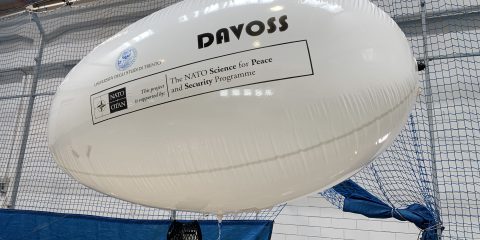Drones, or UAVs (Umanned Aerial Vehicles), represent a technology capable of rapidly gaining large market sectors in civil and consumer frameworks.
People is already acquainted with such flying platforms in applications such as hobby o photo/video professionals. However, the potential and expectations go well beyond what we can even imagine today.
Indeed, the availability of very low cost flying platforms capable of moving in the 3D space is revolutionizing entire sectors and building completely new approaches, such as enabling fast monitoring of critical infrastructures o surveying emergency scenarios, but also delivery of goods and materials. Several companies are investing in building drones capable of carrying different types of payload, even exceeding 50-60 kg, to remote areas. In the delivery scenario, the giant Amazon is well known for experimenting and proposing trial solutions for same-day goods delivery by using unmanned flying platforms, capable for flying for miles to deliver boxes directly to the users’ premises.
We analyzed some of the implications deriving from the usage of drones in civil applications in a research project supported by NATO in the framework of the Science for Peace and Security programme, called DAVOSS (Dynamic Architecture based on UAVs Monitoring for border Security and Safety). During the project, we studied the usage of drones to enable bringing Internet connectivity and services in the most possible agile way by using a swarm of drones. The idea behind the project was the necessity of temporarily bringing communications in emergency scenarios or areas where the coverage is not suitable or sufficient. The technology developed within the project demonstrated that it is possible to set up a swarm of drones and get it ready to provide coverage in minutes. Moreover, exploiting the existing low cost embedded PC platforms such as Raspberry Pi, the swarm of drones can adapt “on the fly” to the mission and reconfigure the set of services to offer based on real-time users’ demand. For example, it is possible in an emergency scenario to “teach” the swarm of drones to analyze their video stream in order to identify the presence of people or cars, or even localize a buried transmitting WiFi or cellular smartphone, in order to ease operation and context awareness of first responders.
In fact, the project allowed our research group to explore also more advanced applications of UAVs in the civil scenario and especially in communications (which is my core expertise), as we studied the possibility to use drones supported by other aerial platforms (e.g. balloons, or low orbit satellites) to build an entire cellular network from scratch, exploiting the flexibility of the new 5G mobile cellular standard.
Overall, the opportunities offered by UAVs are almost endless, and what is amazing is the fact that they extend on most aspects of modern and future society. Civil drones will be likely to impact in the way we move ourselves and our stuff, in how we are aware of the world and how we can interact with it: associating a drone with a Virtual Reality interface, we can experience the World from an entirely different perspective, as well as analyzing places that were out of our reach until today; a company might survey the status of your solar cells simply by flying a drone on top of your house; experts can inspect the quality and security of buildings or bridges directly looking at drone footage; drones can be used to verify quality of cellular coverage to ease network planning or to measure the quality of air in any position, becoming moving active sensors.
All the above applications are within our reach in the near future, even though they require to address some challenges. We can roughly identify two types of challenges: technical challenges and regulatory challenges.
Technical challenges that need to be addressed are mostly related to the battery duration. Today, the duration of the battery is most cases is extremely limited, limiting the deployment of solutions based on UAVs in several scenarios. Furthermore, robust and reliable communications are required in the case of automated drone operation (the so-called BVLOS, or beyond visible line of sight operation) in order to guarantee safety and avoid collision or “traffic control” functionalities.
While the former challenge is being quickly solved with new chemical solutions or the deployment of self-charging landing areas for drones, the latter is more challenging. In fact, no standard worldwide is available to enable drone-to-drone or drone-to-ground communications. 5G cellular networks are being extended to offer backhaul to drones, but of course such services will be limited to the areas covered by this technology. In this scenario, in collaboration with IEEE Standards Association and IEEE Communications Society, we started a standardization research group (IEEE P1954) to properly analyze the current state-of-the-art in drone-to-drone communications and to define a standard capable of supporting such functionality worldwide.
Nevertheless, the biggest issue and probably limiting factor for deployment of UAV-based solutions is the regulatory aspects. Different countries have different regulations for defining who is enabled to drive UAVs or whether it is possible to have BVLOS operation or not. For example, the European Union recently defined a set of common regulations and certifications for drone pilots and the utilization of drones (e.g. altitude, distance from the operator, etc.).
However, the most relevant issue is probably related to support coexistence, safe operation and coordination between UAVs and other flying machinery (helicopters, airplanes, etc.). In this framework, the definition of fast and proper regulations to enable safe drone operation and avoid impacting on other types of air traffic is a necessary step to support a wide area of novel opportunities, especially in cases of automated operation. Indeed, ongoing experiments are being carried in different areas of the world to address the issue of “UAV corridors”, that hopefully could lead to useful feedback about the potential best practices to transform into regulations.
In conclusion, the drones represent a potential breakthrough technology that promises to bring innovation in several aspects of modern society and everyday life. At the moment, not all the building blocks for a drone-enabled society are available, but academia, researchers and companies are already at work to fill the gap and once again bring science fiction to life as fast as possible!
Relevant references:
NATO DAVOSS project: http://nato-davoss.org/
IEEE P1954 standardization group: https://standards.ieee.org/ieee/1954/10686/



